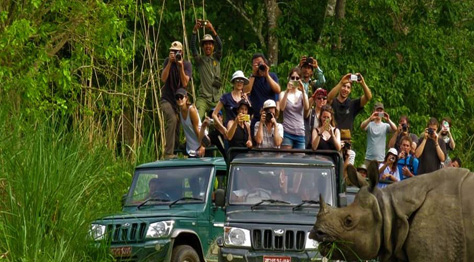Koshi Tappu Wildlife Reserve Camp
Overview
Koshi Tappu Wildlife Camp
Koshi Tappu Wildlife Reserve has carved a place for itself as a birdwatcher’s paradise. The reserve spreads over Saptari and Sunsari districts in East Nepal over the embankments of River Koshi. The reserve has been recognizing as a wetland site from 1987 was established mainly to preserve habitat for the remaining population of wild buffalo in Nepal. The region of Nepal experiences three distinct seasons. Summer lasting from February through May is intensely hot with minimal precipitation. Shade temperatures can reach 40o c. The monsoon commences late May or early June with frequent and violent thunderstorms. Rainfall is greatest during July but high humidity and temperatures are experienced throughout the season. Winter lasts from October through January with unclouded skies and moderate temperatures.
The vegetation of the reserve is mainly grassland with patches of scrub and deciduous riverine forests. The reserve has recorded around 439 species of bird variety some of which fly on the way from Siberia during winter. The best bird can found in Koshi Tappu are, Swamp Francolin, Black-necked Stork, Lesser Adjutant, Comb Duck, Falcated Duck, Spot-billed Duck, Cotton Pigmy Goose, Baer’s Pochard, Bailon’s Crake, Ruddy Crake, Greater Painted Snipe, Pheasant-tailed jacana, Yellow-wattled Lapwing, Indian Courser, Black-bellied Tern, Imperial Eagle, White-tailed Eagle, Lesser Kestrel, Bristle Grass bird, Striated Grass bird etc
Koshi Tappu Wildlife Reserve offers many options and activities to give full opportunities to view the wildlife at its best.
Activities in Koshi Tappu
Morning / Evening Jungle Walk:
The jungle along with the belts of the Koshi River, part of the Koshi Tappu Wildlife Reserve is known for its richness in birds and other animal species. The river lagoons and wetlands provide excellent opportunity to sight bird life, deer and herds of water buffaloes.
Soft Wildlife Rafting:
taking a raft down the Koshi River is another alternative for exploring the reserve. Here, you can see the water birds or animals off to their daily chores with wonderful sights like Kingfishers diving down the river looking for food, the marsh muggers or the ghariyal crocodiles’ sunbathing but of course out of reach. You might be lucky enough to spot the rare wild buffaloes. Down the end, at the barrage Gangetic river dolphins could be your best view of the day.
Village Walk:
This is another interesting activity. Tharus, the early inhabitants of the region have their own unique way of living not affected by the western influence. Their beautifully decorated homes and their way of living can be an interesting part of the tour. The village is also plastic-free, one of the few environmentally aware and clean villages in the country. The Koshi Tappu Wildlife Camp itself took this initiative towards environmental awareness and preservation.
Best Birds to see:
The best bird in Koshi : Swamp Francolin, Black-necked Stork, Lesser Adjutant, Comb Duck, Falcated Duck, Spot-billed Duck, Cotton Pigmy Goose, Baer’s Pochard, Bailon’s Crake, Ruddy Crake, Greater Painted Snipe, Pheasant-tailed jacana, Yellow-wattled Lapwing, Indian Courser, Black-bellied Tern, Imperial Eagle, White-tailed Eagle, Lesser Kestrel, Bristle Grassbird, Striated Grassbird etc
Getting There
By Air:
It is a 45 minutes flight from Kathmandu to Biratnagar. Enjoying the most panoramic view of Eastern Himalayas including Mt. Everest from Biratnagar 1:45 hours drive will reach us to our Deluxe Wildlife Camp.
By Road:
The park is also accessible by road which is 500 km. (about 10 hrs. drive) from Kathmandu to Koshi Tappu Wildlife Reserve.
By Raft:
For white water enthusiasts, the 9 to 10 days exciting trip down the Sun Koshi River can end at the very comfortable camp to recover for your river adventure, enjoying the natural beauty of Koshi Tappu Wildlife Reserve.
Best Time:
The best time to visit this fabulous wildlife reserve is between October to March when much of the migratory and local birds can be sighted at the barrage and many of the river channels. Numerous Himalayan peaks including the Makalu I (8,463m) the fifth highest mountain in the world can be seen during the clear cooler time of the year.
Koshi Tappu Wildlife Reserve Safari Packages
2 nights / 3 days Package
3 nights / 4 days Package and More.
Trip Facts
- Destination: Nepal
- Trip Activities: Jungle Safari
Powered By https://www.friendshipnepaltrek.com















